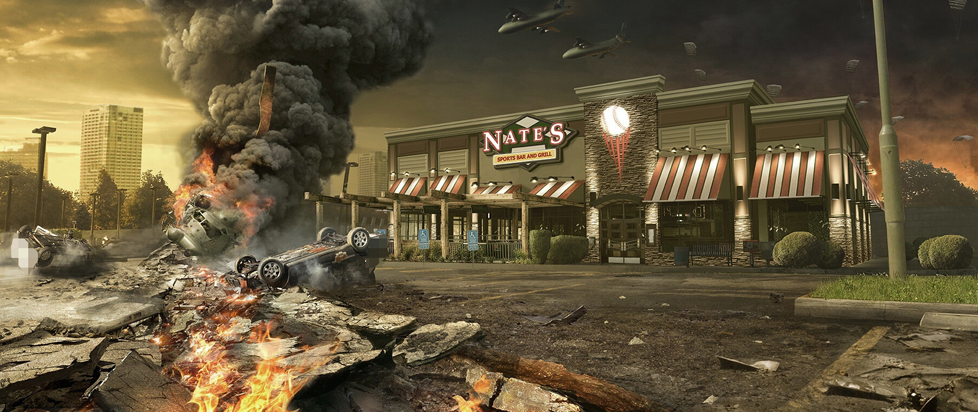
Suburbia Under Siege

This column is a reprint from Unwinnable Monthly #180. If you like what you see, grab the magazine for less than ten dollars, or subscribe and get all future magazines for half price.
———
Architecture and games.
———
While the various entries in the series have been hit or miss, Call of Duty: Modern Warfare 2 managed to hit home, literally. The game is filled with memorable, influential and emblematic levels, but there’s one in particular, “Wolverines,” which takes you into the uncanny territory of a suburban battleground, featuring familiar settings like fast-food joints and white-picket fences, now places of close combat. The level exemplifies a somewhat strangely common theme within the first-person shooter genre, suburban devastation and destruction.
American suburbs have been a cultural symbol of safety, security and stability for decades. These are places where the anxieties frequently associated with the downtown core and the perceived isolation of rural living are smoothed out into uniform rows of identical houses with manicured lawns. They’re assumed to be far removed from the chaos of crime, not to mention conflict. When it comes to “Wolverines,” the illusion is completely shattered. You find yourself defending the unfamiliar territory of strip malls, gas stations and coffee shops.
These places presumably meant for peaceful living destroyed by the chaos of conflict are a far cry from the more exotic environments typically found in Call of Duty. The suburban landscape is mundane to the point that its transformation into a battlefield is both strange and unsettling. The ruined homes, burning vehicles and businesses filled with bullet holes provide a reminder that nowhere is truly safe from the horrible reality of war.
“Wolverines” takes place during a fictional invasion of the United States by Russia, dropping you into the middle of a small town in Virginia. You’re tasked with fending off Russian forces while making your way through banks, burger joints and residential buildings. The level is basically a war movie trope come to life, echoing the fears of a Soviet invasion which never materialized. The suburban setting in Wolverines on the other hand builds an emotional resonance which is entirely particular to the period following the destruction of the Twin Towers, Modern Warfare 2 having been released in 2009.

The sense of discomfort in “Wolverines” doesn’t just come from the physical destruction of the suburban space. The level creates a sense of unease based on what suburbia represents, a collapse of social order and the intrusion of chaos into the most mundane aspects of the American Dream. The name itself is a reference to Red Dawn, a movie which portrayed a similar suburban invasion back in 1984. The game and movie both tap into the same deep-seated fear that such a safe, ordinary place could be turned into a battlefield.
This destruction of suburbia moreover taps into a much broader cultural anxiety affecting the popular mindset ever since the terrorist attacks on New York in 2001. The idea that such a conflict could ever come to the homefront feels more plausible than ever before, seeing as how the last assault on the United States, Pearl Harbor, took place in 1942. Modern Warfare 2 capitalizes on this fear, using the imagery of suburbia under siege to evoke a sense of unease and vulnerability. The discomfort comes not only from seeing these familiar places destroyed but from the realization that such spaces were never truly safe in the first place.
The idea of the homefront being invaded no longer feels like a distant fantasy these days. The sense of unease permeating “Wolverines” could be seen as a reflection of the underlying tension in contemporary society, fears that even the most ordinary and familiar spaces could be transformed into sites of violence and chaos, now an increasingly poignant theme. The destruction of suburbia could of course then be understood as a way of exploring these anxieties, allowing you to confront your fears within a controlled environment, at least from a psychological perspective.
Suburban devastation as explored in “Wolverines” reflects a broader context of growing anxiety and cultural disillusionment which has permeated American society since at least the end of the Cold War. The perceived stability of the period has been increasingly called into question by terrorism, school shootings and intensifying political divisions, with games like Modern Warfare 2 reflecting a growing awareness of these concerns. The site where such fear is materialized frequently seems to be in the suburbs, “Wolverines” having been something of a turning point in terms of its representation within popular media, narrowly preceded by Fallout 3 in 2008. There was for example The Last of Us in 2013, followed by Far Cry 5 and Hitman 2 in 2018, with more destruction sure to follow.
———
Justin Reeve is an archaeologist specializing in architecture, urbanism and spatial theory, but he can frequently be found writing about videogames, too. You can follow him on Twitter @JustinAndyReeve.




